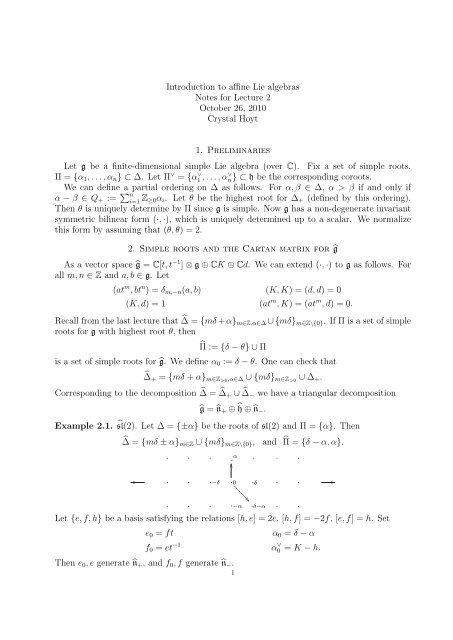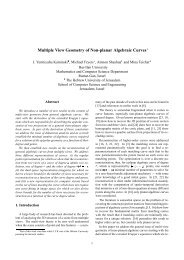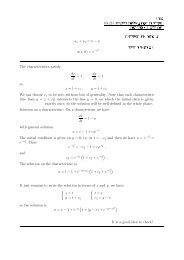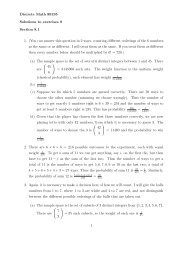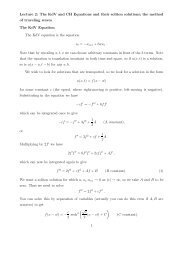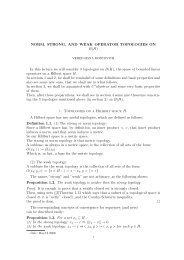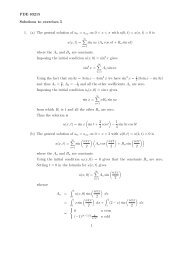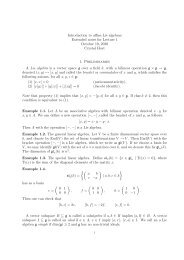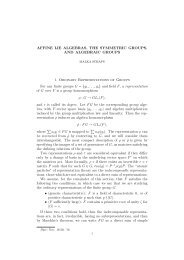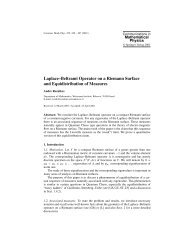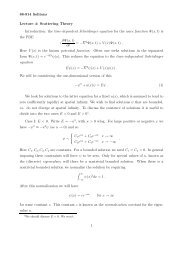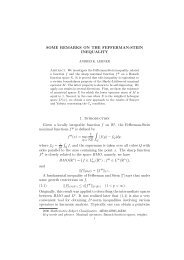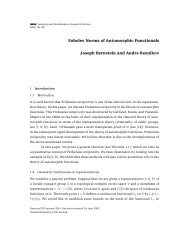Introduction to affine Lie algebras Notes for Lecture 2 October 26 ...
Introduction to affine Lie algebras Notes for Lecture 2 October 26 ...
Introduction to affine Lie algebras Notes for Lecture 2 October 26 ...
Create successful ePaper yourself
Turn your PDF publications into a flip-book with our unique Google optimized e-Paper software.
<strong>Introduction</strong> <strong>to</strong> <strong>affine</strong> <strong>Lie</strong> <strong>algebras</strong><strong>Notes</strong> <strong>for</strong> <strong>Lecture</strong> 2Oc<strong>to</strong>ber <strong>26</strong>, 2010Crystal Hoyt1. PreliminariesLet g be a finite-dimensional simple <strong>Lie</strong> algebra (over C). Fix a set of simple roots.Π = {α 1 , . . . , α n } ⊂ ∆. Let Π ∨ = {α1 ∨ , . . . , αn} ∨ ⊂ h be the corresponding coroots.We can define a partial ordering on ∆ as follows. For α, β ∈ ∆, α > β if and only ifα − β ∈ Q + := ∑ ni=1 Z ≥0α i . Let θ be the highest root <strong>for</strong> ∆ + (defined by this ordering).Then θ is uniquely determine by Π since g is simple. Now g has a non-degenerate invariantsymmetric bilinear <strong>for</strong>m (·, ·), which is uniquely determined up <strong>to</strong> a scalar. We normalizethis <strong>for</strong>m by assuming that (θ, θ) = 2.2. Simple roots and the Cartan matrix <strong>for</strong> ĝAs a vec<strong>to</strong>r space ĝ = C[t, t −1 ] ⊗ g ⊕ CK ⊕ Cd. We can extend (·, ·) <strong>to</strong> g as follows. Forall m, n ∈ Z and a, b ∈ g. Let(at m , bt n ) = δ m,−n (a, b) (K, K) = (d, d) = 0(K, d) = 1 (at m , K) = (at m , d) = 0.Recall from the last lecture that ̂∆ = {mδ + α} m∈Z,α∈∆ ∪ {mδ} m∈Z\{0} . If Π is a set of simpleroots <strong>for</strong> g with highest root θ, then̂Π := {δ − θ} ∪ Πis a set of simple roots <strong>for</strong> ĝ. We define α 0 := δ − θ. One can check that̂∆ + = {mδ + α} m∈Z>0 ,α∈∆ ∪ {mδ} m∈Z>0 ∪ ∆ + .Corresponding <strong>to</strong> the decomposition ̂∆ = ̂∆ + ∪ ̂∆ − we have a triangular decompositionExample 2.1.ĝ = ̂n + ⊕ ĥ ⊕ ̂n −.ŝl(2). Let ∆ = {±α} be the roots of sl(2) and Π = {α}. Then̂∆ = {mδ ± α} m∈Z ∪ {mδ} m∈Z\{0} ,. . . . α . . .and ̂Π = {δ − α, α}.. . . −δ . 0 . δ . . . . . . −α . δ−α . .Let {e, f, h} be a basis satisfying the relations [h, e] = 2e, [h, f] = −2f, [e, f] = h. Sete 0 = ftα 0 = δ − αf 0 = et −1 α ∨ 0 = K − h.Then e 0 , e generate ̂n + , and f 0 , f generate ̂n − .1
The Cartan matrix and Dynkin diagram of ŝl(2) are( )2 −2A =○−2 2 ○ .Now we look at the general case. Let ω : g → g be the Chevalley involution, which isdefined by e i ↦→ −f i : i = 1, . . . , n and h ↦→ −h <strong>for</strong> all h ∈ h. Take f θ ∈ g −θ such that(−ω(f θ ), f θ ) = 1. Let e θ = −ω(f θ ). Then [e θ , f θ ] = θ ∨ . Sete 0 = f θ tα 0 = δ − θf 0 = e θ t −1 α ∨ 0 = K − θ ∨ .For i = 1, . . . , n, choose e i ∈ g αi , f i ∈ g −αi such that [e i , f i ] = α ∨ i . Then e 0 , e 1 , . . . , e ngenerate ̂n + , and f 0 , f 1 , . . . , f n generate ̂n − .The Cartan matrix A <strong>for</strong> ĝ is obtained from the Cartan matrix A ′ <strong>for</strong> g by adding onerow and column. Explicitly, a i0 = 〈α ∨ i , α 0 〉 = −〈α ∨ i , θ〉 and a 0i = 〈α ∨ 0 , α i 〉 = −〈α i , θ ∨ 〉. NowA ′ is invertible and the corank of A is 1.3. Kac-Moody <strong>algebras</strong>An n × n-matrix is called a generalized Cartan matrix if <strong>for</strong> i, j = 1, . . . , n,• a ii = 2• a ij ∈ Z ≤0 <strong>for</strong> i ≠ j• a ij = 0 ⇔ a ji = 0.Let A be a generalized Cartan matrix, and let h be a vec<strong>to</strong>r space (over C) with dimensionn + corank(A). Letbe linearly independent sets satisfyingΠ = {α 1 , . . . , α n } ⊂ h ∗Π ∨ = {α ∨ 1 , . . . , α ∨ n} ⊂ h〈α ∨ i , α j 〉 = a ij .Define ḡ(A) by genera<strong>to</strong>rs: e 1 , . . . , e n , f 1 , . . . , f n , h and relations:[e i , f j ] = δ ij α ∨ i [h, e i ] = 〈h, α i 〉e i[h, h ′ ] = 0 [h, f i ] = −〈h, α i 〉f i .Let m be the unique maximal ideal which intersects h trivially. Then the Kac-Moodyalgebra with Cartan matrix A is defined <strong>to</strong> beg(A) := ḡ(A)/m.One can check that the genera<strong>to</strong>rs of g(A) satisfy the Serre’s relations (i ≠ j):(ad e i ) 1−a ije j = 0(ad f i ) 1−a ijf j = 0If the matrix A is “symmetrizable” then these relations generate the ideal m. In other words,these are the only additional relations needed <strong>to</strong> define g(A).2
A matrix A is called symmetrizable if there exists an invertible diagonal matrix D and asymmetric matrix B such that A = DB. In this case, g(A) is also called symmetrizable.The Kac-Moody algebra g(A) is symmetrizable if and only if there exists a nondegenerateinvariant symmetric bilinear <strong>for</strong>m on g(A).Affine <strong>Lie</strong> <strong>algebras</strong> are Kac-Moody <strong>algebras</strong>. If A is the Cartan matrix of ĝ, then there isan isomorphism ĝ ∼ = g(A) which can be defined using the Chevalley genera<strong>to</strong>rs. Similarly,finite-dimensional simple <strong>Lie</strong> <strong>algebras</strong> and twisted <strong>affine</strong> <strong>Lie</strong> <strong>algebras</strong> are Kac-Moody <strong>algebras</strong>.Given a Kac-Moody algebra g(A) such that A is the Cartan matrix on an <strong>affine</strong> <strong>Lie</strong>algebra, we can recover the elements K and δ which were previously defined. It follows from[K, e i ] = 0 <strong>for</strong> i = 0, 1, . . . , n that 〈K, α i 〉 = 0 <strong>for</strong> i = 0, 1, . . . , n. Let [a ∨ i ] be a row vec<strong>to</strong>rsuch that [a ∨ i ]A = 0. It is determined up <strong>to</strong> a scalar since the corank of A is 1. We choosea ∨ 0 , . . . , a ∨ n <strong>to</strong> be relatively prime integers. Thenn∑K = a ∨ i αi ∨ .Similarly, 〈αi ∨ , δ〉 = 0 <strong>for</strong> i = 0, 1, . . . , n.integers such that A[a i ] = 0. Thenδ =i=0So we choose a 0 , . . . , a n <strong>to</strong> be relatively primen∑a i α i .i=0Simple finite-dimensional, <strong>affine</strong> and twisted <strong>affine</strong> <strong>Lie</strong> <strong>algebras</strong> are all the Kac-Moody<strong>algebras</strong> of “finite growth”. The principal gradingg = ⊕ m∈Z g(m)of g <strong>for</strong> a set of simple roots Π is defined by g(0) = h andg(1) = ⊕ αi ∈Πg αi .Then g is said <strong>to</strong> have finite growth if dim g(m) grows polynomially with respect <strong>to</strong> m, andthe Gelfand-Kirillov dimension is the degree of this polynomial. For <strong>affine</strong> and twisted <strong>affine</strong><strong>Lie</strong> <strong>algebras</strong>, the Gelfand-Kirillov dimension is 1.4. Affine Weyl groupLet g be a finite-dimensional simple <strong>Lie</strong> algebra, h ⊂ g a Cartan subalgebra and fix a baseΠ ⊂ ∆. Let (·, ·) be the non-degenerate invariant symmetric bilinear <strong>for</strong>m normalized suchthat (θ, θ) = 2. Recall that θ is the highest root of ∆ + .For j = 0, 1, . . . , n, define Λ j ∈ ĥ∗ by〈α ∨ i , Λ j 〉 = δ ij <strong>for</strong> i = 0, . . . , n, and 〈d, Λ j 〉 = 0.We identify ĥ with ĥ∗ via the linear map ν : ĥ → ĥ∗ defined by ν(α ∨ i ) = (α∨ i ,α∨ i )2α i , ν(K) = δ,ν(d) = a 0 Λ 0 . For α, β ∈ ĥ∗ , define (α, β) := (ν −1 (α), ν −1 (β)).3
Simple reflections at the roots α i : i = 0, 1 . . . , n are defined as follows. For λ ∈ ĥ∗ , letr i (λ) = λ − 2(λ, α i)(α i , α i ) α i.The <strong>affine</strong> Weyl group Ŵ is the group generated by r 0, r 1 , . . . , r n . The subgroup W generatedby r 1 , . . . , r n is canonically isomorphic <strong>to</strong> the Weyl group of g.To simplify notation, fix λ ∈ ĥ∗ and set k = 〈λ, K〉 = (λ, δ). Thenr 0 (λ) = λ − ((λ, θ) − k)(δ − θ)andr 0 r θ (λ) = λ − ((λ, θ) + k)δ + kθ.For µ ∈ h ∗ , define the translation(µ, µ)t µ (λ) = λ + kµ − ((λ, µ) + k )δ.2One can check thatHence,t θ = r 0 r θt µ t µ ′ = t µ+µ ′t wµ = wt µ w −1 <strong>for</strong> all w ∈ W.T := {t µ | µ ∈ Z(W θ)}is a normal subgroup of Ŵ . Since W is finite and T is free abelian, W ∩ T = 1. Thus,W ⋉ T is a subgroup of Ŵ . Now r i ∈ W ⊂ Ŵ <strong>for</strong> i = 1, . . . , n and r 0 = t θ r θ ∈ W ⋉ T . Sincer 0 , r 1 , . . . , r n generate Ŵ , we conclude thatŴ = W ⋉ T.4


